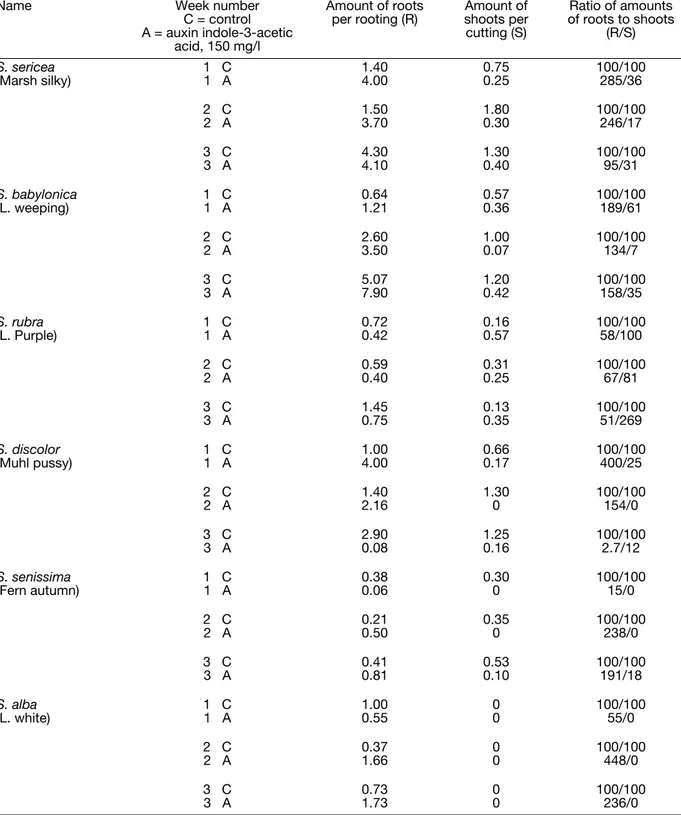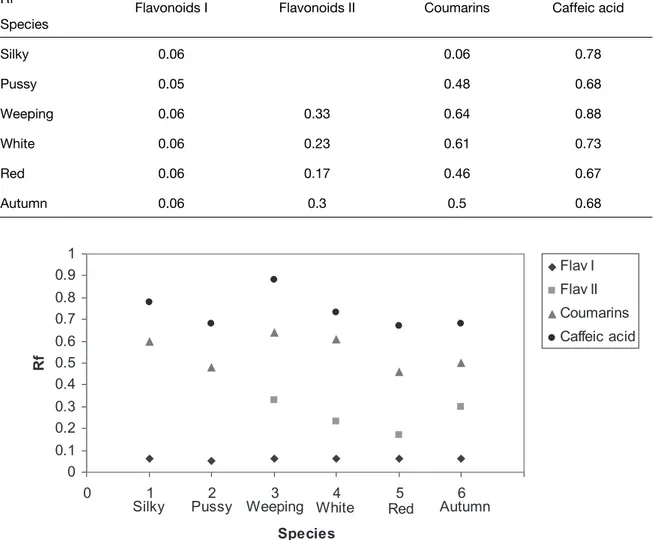Valentine Kefeli, Chris Lininger
and Ratty Shultz
Slippery Rock University, Slippery Rock PA 16057, USA
Abstract
Willows could be good objects for water cleaning and landscape rehabilitation. Their reaction on auxin and phenolic quality could be used as chemo-taxonomic factors. In comparison with morphological properties they could be applied for willow species identification. The quality of phenolics may help to identify different plant species.
Key words: Chemotaxonomy, auxins, phenolic substances, flavonoids, coumarins.
Introduction
Willows could be good objects for water cleaning and landscape rehabilitation (Kefeli, 2007). Their reaction on auxin and phenolic quality could be used as chemo-taxonomic factors. In comparison with morphological properties they could be applied for willow species identification (Kefeli and Kalevitch, 2003).
Phenolics are the secondary products of photosynthesis which participate in xylemogenesis (lignin formation) or are deposited in the form of glycosides in the vacuoles. They are easily observed on paper chromatograms in UV-B light. There are many functions of phenolics in plants: they participate in respiration as substrates for oxidations, some of them modify auxin activity in the plants, and some are substrates of the root allelopath- secretions from the roots (inhibiting and sanitary properties). The quality of phenolics may help to identify different plant species, as it was shown by Harborne (1964).
Materials and methods
Willow cuttings were rooted in water or in indole-acetic acid, 150 mg/l. The type of rooting might be a factor of chemotaxonomy.
Leaves of different species of willow growing on fabricated soil (Kefeli, 2007; Kefeli and Dunn, 2007) were extracted by water in a ratio of 1:5. Water extract was applied to Whatmann 1 paper chromatography using 5% acetic acid as a solvent, ascending way. Chromatograms were dried, treated by saturated soda solution and investigated in UV-B light.
Results
Some physiological and biochemical properties of willows were used for willow species determination. The most pronounced physiological process is rooting and the effect of auxins on rooting.
The data show that different willow species have different properties of rooting in the fall and different reactions on auxin. These parameters could be used as a chemo-taxonomic factor.
The other factor of chemotaxonomy is phenolics which were observed on the chromatograms as different fluorescent spots. Flavonoids and their glucosides were identified using Rf, color reactions, and change of color by soda reagent. The same parameters were used for the identification of coumarins and phenolic acids (Kefeli and Kalevitch, 2003).
Two types of flavonoids were observed for willows. One with low Rf and the second with higher Rf. They are easily separated from the other. Silky and pussy willows contain only one flavonoid with low Rf. Silky willow also has a low Rf for coumarin. Caffeic acid was present in all willow species and therefore could not be used for willow taxonomy.
Chemotaxonomy of willow species could be recommended for an investigation of flavonoids and coumarins. Phenolic acids are not specific for the process of identification. Chemo-taxonomy might be a supplemental tool for identification of willow species. It might also be very important for the investigation of the cross-pollinated forms.
Advances in Molecular Biology (1): 85-88, 2007
‹stanbul Kültür University, Printed in Turkey www.advmolbiol.org
*Correspondence Author:
Slippery Rock University, Slippery Rock PA 16057, USA E-mail: valentin@pathway.net
Received: June 18, 2007; Accepted: August 27, 2007.
Chemotaxonomy of willow
Kefeli et al.
86
Advances in Molecular Biology
Name Week number
C = control A = auxin indole‐3‐acetic
acid, 150 mg/l
Amount of roots
per rooting (R) shoots per Amount of cutting (S) Ratio of amounts of roots to shoots (R/S) S. sericea (Marsh silky) 1 C1 A 1.404.00 0.750.25 100/100285/36 2 C 2 A 1.503.70 1.800.30 100/100246/17 3 C 3 A 4.304.10 1.300.40 100/10095/31 S. babylonica (L. weeping) 1 C1 A 0.641.21 0.570.36 100/100189/61 2 C 2 A 2.603.50 1.000.07 100/100134/7 3 C 3 A 5.077.90 1.200.42 100/100158/35 S. rubra (L. Purple) 1 C1 A 0.720.42 0.160.57 100/10058/100 2 C 2 A 0.590.40 0.310.25 100/10067/81 3 C 3 A 1.450.75 0.130.35 100/10051/269 S. discolor (Muhl pussy) 1 C1 A 1.004.00 0.660.17 100/100400/25 2 C 2 A 1.402.16 1.300 100/100154/0 3 C 3 A 2.900.08 1.250.16 100/1002.7/12 S. senissima (Fern autumn) 1 C1 A 0.380.06 0.300 100/10015/0 2 C 2 A 0.210.50 0.350 100/100238/0 3 C 3 A 0.410.81 0.530.10 100/100191/18 S. alba (L. white) 1 C1 A 1.000.55 00 100/10055/0 2 C 2 A 0.371.66 00 100/100448/0 3 C 3 A 0.731.73 00 100/100236/0
Table 1: Rooting as a Taxonomic Factor for Willow. Experiment started on September 25, 2004 and took place at Alter Lab,
Discussion and conclusion
The reaction of cuttings of willow species on auxin could be a factor for chemotaxonomy. The pattern of phenolic substances in willow leaves was also different for the six investigated willow species (Kefeli and Kalevitch, 2003). Among the phenolics are flavonoids of the salipurposide and luteolin family, chlorogenic acid, and oxi-coumarins. Leaves of the six willow species were investigated on the qualitative characteristics of observed phenolics in the six willow species. Water extracts of the leaves were subjected to ascending paper chromatography (solvent- 5% acetic acid). Willow flavonoids (Rf 0.1-0.4) were identified by Rf, UV-B’s, soda reagent, and soda+ UV-B.
Both silky and pussy willow had one flavonoid and weeping willow had two flavonoids. Autumn, purple and white willows had 3-4 flavonoids (luteolin, salipurposide, isosalipurposide). All flavonoids are in glucoside forms. A flavonoid complex was isolated for each willow from Whatmann 3M paper and rechromatographed in 70% isopropanol for further identification. Water soluble extracts from the leaves were applied to silky willow cuttings before rooting. Extracts from leaves of purple and white willow (deep dormancy) inhibited the rooting process. Willow flavonoids could be used as tests for willow chemotaxonomy (Harborne, 1964).
Chemotaxonomy of willow
Kefeli et al.
87
Advances in Molecular Biology Rf
Species Flavonoids I Flavonoids II Coumarins Caffeic acid
Silky 0.06 0.06 0.78 Pussy 0.05 0.48 0.68 Weeping 0.06 0.33 0.64 0.88 White 0.06 0.23 0.61 0.73 Red 0.06 0.17 0.46 0.67 Autumn 0.06 0.3 0.5 0.68
Table 2: Comparative data on willow species. Ascending paper chromatography.
References
Harborne J. Phenolic glucosides. In: Biochemistry of phenolic compounds. Academic Press. p. 129, 1964.
Kefeli V and Kalevitch M. Natural Growth Inhibitors and Phytohormones in Plants and Environment. Kluwer Acad Publ. 141 p: 2003.
Kefeli V. Water cleaning and wetland construction. Int J Environ and Pollut. 29: 4: 383, 2007.
Kefeli V and Dunn M. Fabricated soil in landscape rehabilitation. Int J Environ and Pollut. 29: 34, 4053, 2007.
Chemotaxonomy of willow
Kefeli et al.

